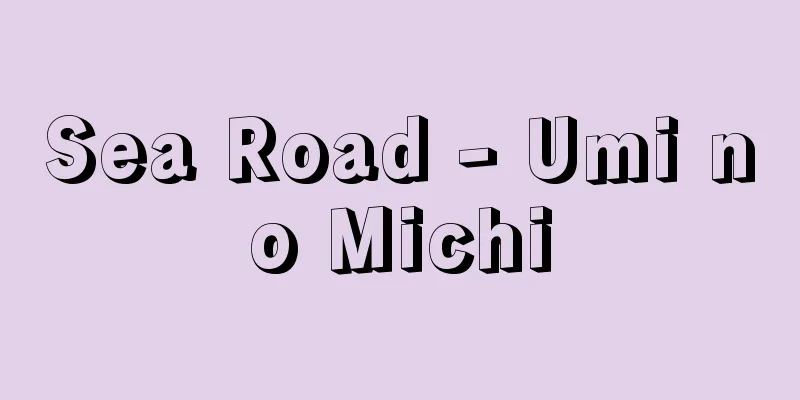Sea Road - Umi no Michi

|
A maritime trunk route that originates from the southeast coast of China and passes through the East China Sea, the Indian Ocean, the Persian Gulf, and the Red Sea to the Middle East. It is also called the "Maritime Silk Road." This sea route transported Chinese goods such as silk and ceramics to Southwest Asia, and Southwest Asian goods such as glass and spices to China. Faxian of the Eastern Jin Dynasty and Yijing of the Tang Dynasty hitched a ride on a South Sea ship traveling along this route on their way back from India. During the Song and Yuan dynasties, larger Chinese ships began sailing on ocean voyages east of Qilon in southern India, and the area west of there belonged to the area of activity of Persian and Arab ships, which had relatively shallow drafts. The 13th century Persian poet Sa'di wrote about the transport of sulfur from Persia to China, porcelain from China to Byzantium, brocade from Byzantium to India, steel from India to Syria, glass from Syria to Yemen, and striped textiles from Yemen to Persia. The 15th century writings of Ibn Majid described a sea route that began at Hormuz in the Persian Gulf and passed through India to China. The route was as follows: First, it reached Sindh in northwest India, then traveled south along the west coast of India, skirted the south of Ceylon, stopped at Martaban in Burma (Myanmar), traveled south along the west coast of the Malay Peninsula, and reached Malacca (Malacca), the center of South Sea trade. It then stopped at Singapore, passed through Patani and Sunkhla on the east coast of the Malay Peninsula, and reached Ayutthaya, the capital of Thailand. From there, it passed through Cambodia and Champa in Indochina, and reached Guangzhou (Kantung) and Quanzhou (Zaytung). [Keishiro Sato] "Study of Islamic Commercial History" by Keishiro Sato (1980, Dohosha Publishing) Source: Shogakukan Encyclopedia Nipponica About Encyclopedia Nipponica Information | Legend |
|
中国の南東海岸より発して、東シナ海、インド洋、ペルシア湾または紅海を経て中東諸国に通ずる海の幹線路。「海のシルク・ロード」ともいう。この海路により、絹、陶磁器などの中国物資が西南アジアに、ガラス、香辛料などの西南アジア物資が中国に運ばれた。東晋(とうしん)の法顕(ほっけん)、唐の義浄(ぎじょう)などは、インドからの帰路、この経路を往来する南海船に便乗している。宋(そう)・元(げん)時代になると、大型化した中国船がインド南部のキーロン(クイロン)以東の大洋航海に就航し、それより以西は喫水が比較的浅いペルシア、アラブ船の活動海域に属した。13世紀のペルシア詩人サーディーの著作に、ペルシアから中国へ硫黄(いおう)を、中国からビザンティンへ磁器を、ビザンティンからインドへ錦(にしき)を、インドからシリアへ鋼鉄を、シリアからイエメンへガラスを、イエメンからペルシアへ縞(しま)織物を運ぶと記される。15世紀のイブン・マージドの著作には、ペルシア湾のホルムズを発しインドを経由して中国に至る海路が記されている。 その経路は以下のとおりである。まず西北インドのシンドに至り、インド西海岸を南下し、セイロン島の南を迂回(うかい)し、ビルマ(ミャンマー)のマルタバンに立ち寄り、マレー半島の西岸を南下し、南海貿易の中心地マラーカ(マラッカ)に達する。ついでシンガポールに立ち寄り、マレー半島東岸のパタニ、スンクラを経由して、タイの首都アユタヤに至る。それよりインドシナのカンボジア、チャンパを経由、広州(カントゥン)、泉州(ザイトゥン)に達する。 [佐藤圭四郎] 『佐藤圭四郎著『イスラーム商業史の研究』(1980・同朋舎出版)』 出典 小学館 日本大百科全書(ニッポニカ)日本大百科全書(ニッポニカ)について 情報 | 凡例 |
Recommend
Bogdan
…He fondly remembered the hunt and made the head ...
Picking at your own will - Picking at your own will
...When the fishing port is opened, the collectiv...
Umlaut (English notation)
A phenomenon unique to the Germanic branch of the ...
Consul - (English spelling) consul (Latin)
The highest office (highest magistrate) in ancien...
"Kanno Shinsho" - Kanno Shinsho
…He served in the same domain in his youth, but a...
Kibinago (Kibinago) - Kibinago (English spelling) blue sprat
A marine fish of the Clupeidae family (illustratio...
Bald mountain - Hageyama
Generally, the term refers to a mountain without t...
Tai people - Tai (English spelling) Dai
A minority ethnic group of Dai living in the south...
Besold, C.
The four fundamental documents are the pamphlet &...
Wirye Fortress - Wirye Fortress (English spelling)
The first capital of Baekje, one of the three anci...
gemeines Deutsch (English spelling) gemeinesDeutsch
...However, the language gradually became uniform...
bocage
… One thing that catches people's eye more th...
Rahman, Mujibur
Born: March 17, 1920, Faridpur, Bengal Died: Augus...
Anchovy - anchovy (English spelling)
Anchovy is the English name for a small fish simi...
Blume, Friedrich
Born January 5, 1893 in Schlüchtern [Died] Novembe...









